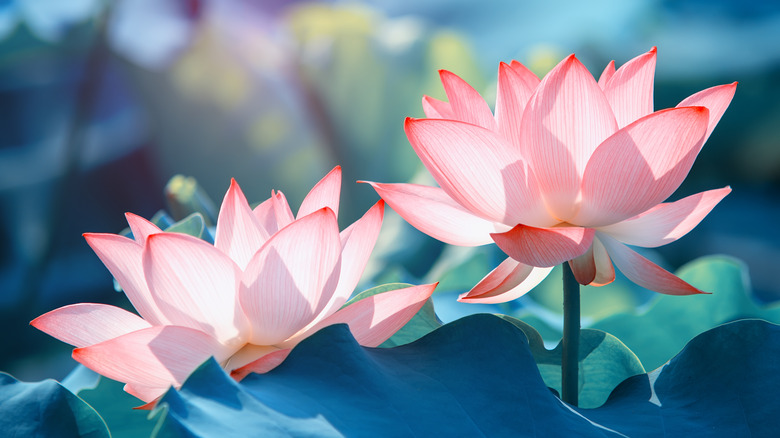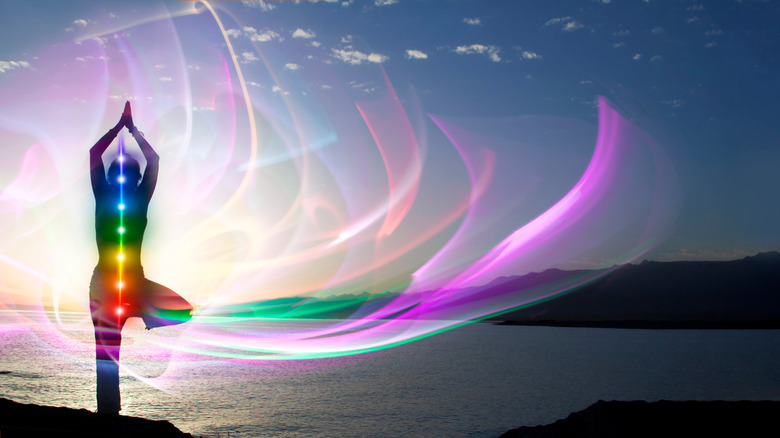A Beginners Guide To Chakra Work
If you've ever watched in wonder as a circus performer — outfitted with poles on outstretched arms — managed to keep a legion of plates spinning above their head, you might be surprised to find out that you are doing something quite similar within the confines of your subtle body. Plate spinning, much like chakra maintenance, is all about balance.
Chakras, as defined by Healthline, are energy centers in the body. Disc-like spinning vortexes are positioned along the spinal column, starting at the base of the spine and ending just above the top of the head. Chakras have deep roots in the spiritual realm and have long been written off for that very reason. However, research has begun to show that certain chakras may be tethered to nerve groups and major organs. As a result, they can have a measurable impact on both our emotional and physical wellness when misaligned.
According to a paper published in Psychology Review, it's believed that the study of the chakra system began in India between 1500 and 500 BC when the Vedas, Hinduism's earliest scriptures, were written. However, many scholars believe the practice of chakra work was passed down as an oral tradition long before that. The philosophy of chakras, much like other traditional systems of medicine, is based on the idea of duality and the balance between feminine and masculine forces. Shakti and Shiva — creation and consciousness — make up everything in the universe, and everything in us, too.
What does it mean to balance the chakras?
When you consider anything that requires two opposing forces to reach equilibrium — attraction and repulsion, negative and positive — the concept can be illustrated by imagining the scales of justice. When there's too much of one and not enough of the other, one side of the scale sinks to the ground while the other shoots toward the sky. The relationship between Shiva and Shakti and their influence over our bodies is no different. Like with most things in life, we want to keep the masculine and feminine balanced. When there's dissonance in our energy centers, it can have a tangible impact on our cognition, behavior, and physical body (per Psychology Review).
According to MindBodyGreen, there are seven chakras. When they are each balanced and open, energy is able to flow freely between them. When stress or destructive thought processes and behaviors cause chakras to fall out of balance, it can have psychological and physiological repercussions (per Healthline). Yoga medicine therapeutic specialist Dr. Diane Malaspina explained that chakras can become imbalanced when there's too little or too much energy moving through the body. When a chakra has low energy, you will struggle to express the qualities associated with that chakra, and affiliated organ systems may also suffer. If a chakra is overactive, the qualities associated with it will be dominant to a fault. For example, if the solar plexus chakra controls feelings of personal power, an overactive third chakra could result in aggression.
What does science have to say?
While scientific evidence has yet to support the spiritual elements surrounding the chakra system, there is a growing body of research that supports the idea that chakras might correspond to specific parts of the body. A cadaver study published in Ayu found that the Muladhara, or root chakra, is closely associated with the inferior hypogastric plexus. This influences the reproductive organs and the rectum, aligning perfectly with what the root chakra is said to hold power over. Another study in the Indian Journal of Medical Research and Pharmaceutical Sciences determined that the cardiac plexus corresponds to the heart chakra, not just in location, but in functionality.
A review of multiple studies published in Complementary Therapies in Clinical Practice involved biofield therapies, which measure electric and magnetic currents in the areas where chakras are positioned. It confirmed measurable frequencies emitting from said areas that went far above or below normal ranges.
This is still a growing field of research, and few studies have been conducted to measure whether or not chakra therapy works. MedicalNewsToday reports that because chakra therapy often includes meditation, yoga, and other practices that illicit introspection and evoke feelings of well-being, there are benefits to chakra-based work. One 2020 study published in the International Journal of Social Welfare Promotion and Management was conducted on 223 people following a chakra-based meditation program. Researchers found that participants reported feeling less anxiety and an overall sense of better health.
The root and the sacrum
Muladhara, or the root chakra, is located at the base of the spine and is associated with the color red (per MindBodyGreen). When visualizing your root chakra, imagine a spinning disc of red light near your tailbone. The root chakra's related to survival, security, and groundedness. An imbalance has emotional implications like fear, disconnection, and financial insecurity (per Healthline). In the physical body, it can appear as constipation, kidney problems, or arthritis. To realign Muladhara, you can try a visualization meditation where tree-like roots grow from your glowing red root chakra through the chair you're sitting on, past your floorboards, and deep into the soil, grounding you. Use grounding mantras like, "I'm safe," and "I'm right where I need to be," and strongly rooted yoga poses like Mountain pose.
Swadhisthana, the sacral chakra, is an orange disc in our navel that rules sexuality, creativity, and how we emote (per MindBodyGreen). When the second chakra is out of whack, Healthline says it might show up in your body as reproductive issues, urinary infections, or low libido. Emotionally, it can affect our inspiration and self-worth. A sacral chakra visualization meditation might look like the orange disc in your navel opening up and a rush of clean, cool water flowing through it. MindBodyGreen suggests a self-loving mantra. Maybe that sounds something like "I love myself and my body," or "I am creative, capable, and inspired." You might also try a bridge or pigeon yoga pose (per Healthline).
The solar plexus and the heart
Manipura, the yellow solar plexus chakra, is in the stomach (per MindBodyGreen). It governs our ego, confidence, and personal power. When your solar plexus chakra is in good shape, you will feel free to be your true self. When it's out of balance, you might find yourself feeling a great deal of shame and self-doubt. It may show up in your body as digestive problems, heartburn, ulcers, and eating disorders (per Healthline). A meditation where you imagine a fire in your stomach burning all of your insecurities might set things straight. "I accept all parts of myself," and "I am responsible for all areas of my life” are great Manipura mantras, along with bow and pike poses (per MindBodyGreen).
Anahata is the heart chakra and its color is green. As you might imagine, the heart chakra rules joy, peace, and our ability to give and receive love. A heart chakra imbalance might cause depression, difficulty with intimacy, and passivity. Healthline notes that while it can show up in the body as heart or lung problems and weight gain, it typically presents in one's behavior. Balancing the heart chakra can be done through meditation. Imagine your heart as a flower. With every inhale, the flower opens until it fully blooms. MindBodyGreen suggests loving mantras like, "I love myself and others, as I am them and they are me." Yoga poses to open the heart chakra include camel (per Yoga Journal) and cobra (per Yoga Journal).
Throat, third eye, and crown
Vishuddha is the throat chakra, its color is light blue, and it dictates communication. When it's in good shape, we are able to clearly express our feelings and boundaries and understand those of others. When it's suffering, we might struggle to find the words to express our truth, dominate conversations, or speak harshly (per Healthline). Singing and chanting can help unblock the throat chakra, as well as a mantra like, "I speak with intention," and practicing the fish pose (per MindBodyGreen).
Ajna is the third-eye chakra, which sits on the forehead between the eyes. Its color is indigo, and that's where our intuition and wisdom lie. It's believed that a healthy Anja can see beyond what meets the eye. A closed third eye can result in headaches, eye strain, or a feeling like you are out of touch with your purpose (per Healthline). To open up your third eye, meditate on a serene place drenched in indigo. MindBodyGreen offers a mantra similar to, "I'm open to seeing the truth," and child's pose.
Sahasrara is the crown chakra, located just above the top of the head, and it's the window to enlightenment. Because it's connected to all the other chakras, it is said when the crown's open (which very few achieve), life feels blissful. A blockage may look like narrow-mindedness or stubbornness (per Healthline). Mantras like, "I am a vessel for love and light," and headstands can help access the crown chakra (per MindBodyGreen).






